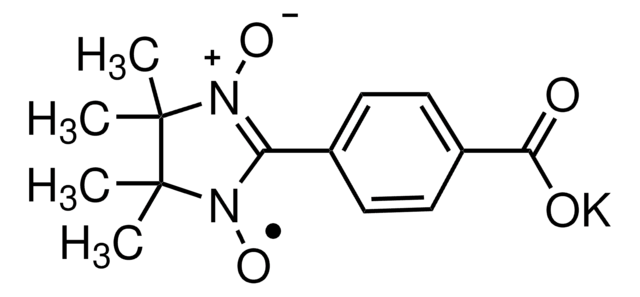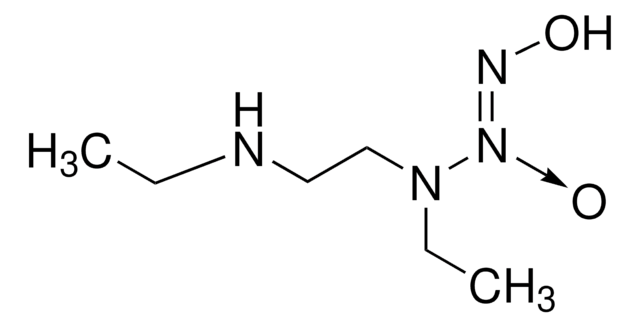N4148
S-Nitrosoglutathione
≥97%
Sinónimos:
GSNO, SNOG
Iniciar sesiónpara Ver la Fijación de precios por contrato y de la organización
About This Item
Fórmula empírica (notación de Hill):
C10H16N4O7S
Número de CAS:
Peso molecular:
336.32
MDL number:
UNSPSC Code:
12352200
PubChem Substance ID:
NACRES:
NA.32
Productos recomendados
Quality Level
assay
≥97%
form
powder
solubility
water: soluble 19.60-20.40 mg/mL
storage temp.
−20°C
SMILES string
N[C@@H](CCC(=O)N[C@@H](CSN=O)C(=O)NCC(O)=O)C(O)=O
InChI
1S/C10H16N4O7S/c11-5(10(19)20)1-2-7(15)13-6(4-22-14-21)9(18)12-3-8(16)17/h5-6H,1-4,11H2,(H,12,18)(H,13,15)(H,16,17)(H,19,20)/t5-,6-/m0/s1
InChI key
HYHSBSXUHZOYLX-WDSKDSINSA-N
General description
S-Nitrosoglutathione (GSNO) is an endogenous nitrogen oxide and is highly distributed in extracellular fluids of the lung and brain.
Application
S-Nitrosoglutathione (GSNO) has been used:
- as a standard in reversed phase chromatography coupled to chemical vapour generation and atomic fluorescence detector (RPC-CVGAFS) and reversed phase chromatography fluorimetric (RPC-FD).
- as a standard in spectrophotometric and high-performance liquid chromatography (HPLC) assay.
Biochem/physiol Actions
S-Nitrosoglutathione (GSNO) inhibits the activity of sarcoplasmic reticulum-bound creatine kinase in rabbit skeletal muscle and eventually reduces ATP driven Ca2+ uptake in sarcoplasmic reticulum vesicles. GSNO in airway cells relaxes airway smooth muscle and enhances airway ciliary motility. It also blocks airway epithelial amiloride-sensitive sodium transport while stimulating calcium-dependent epithelial chloride transport and induces neutrophilic apoptosis. In addition, it also has antimicrobial activity. GSNO concentration is low in cystic fibrosis (CF) airway. It is an NO donor, acts as a smooth muscle relaxant, vasodilator and inhibits platelet activation in vivo.
Storage Class
11 - Combustible Solids
wgk_germany
WGK 3
ppe
dust mask type N95 (US), Eyeshields, Gloves
Elija entre una de las versiones más recientes:
¿Ya tiene este producto?
Encuentre la documentación para los productos que ha comprado recientemente en la Biblioteca de documentos.
Los clientes también vieron
Shuangchen Chen et al.
Frontiers in plant science, 8, 1109-1109 (2017-07-18)
Ubiquitination is a common regulatory mechanism, playing a critical role in diverse cellular and developmental processes in eukaryotes. However, a few reports on the functional correlation between E3 ubiquitin ligases and reactive oxygen species (ROS) or reactive nitrogen species (RNS)
Hugo Varet et al.
Scientific reports, 8(1), 9042-9042 (2018-06-15)
Oxidative stress is one of the strongest toxic factors in nature: it can harm or even kill cells. Cellular means of subverting the toxicity of oxidative stress are important for the success of infectious diseases. Many types of bacterium inhabit
Yu-Chen Yang et al.
Antioxidants & redox signaling, 18(10), 1129-1140 (2012-09-25)
Both cancer-suppressing and cancer-promoting properties of reactive nitrogen and oxygen species (RNOS) have been suggested to play a role in tumor pathology, particularly those activities associated with chronic inflammation. Here, we address the impact of nitric oxide (NO) on the
Benjamin Gaston et al.
American journal of respiratory and critical care medicine, 173(11), 1186-1193 (2006-03-11)
Genetic and biochemical data demonstrate a pivotal role for S-nitrosothiols (SNOs) in mediating the actions of nitric oxide synthases (NOSs). SNOs serve to convey NO bioactivity and to regulate protein function. This understanding is of immediate interest to the pulmonary
C C Chiueh et al.
Free radical research, 31(6), 641-650 (2000-01-12)
Recent results demonstrated that S-nitrosoglutathione (GSNO) and nitric oxide (*NO) protect brain dopamine neurons from hydroxyl radical (*OH)-induced oxidative stress in vivo because they are potent antioxidants. GSNO and *NO terminate oxidant stress in the brain by (i) inhibiting iron-stimulated
Nuestro equipo de científicos tiene experiencia en todas las áreas de investigación: Ciencias de la vida, Ciencia de los materiales, Síntesis química, Cromatografía, Analítica y muchas otras.
Póngase en contacto con el Servicio técnico








